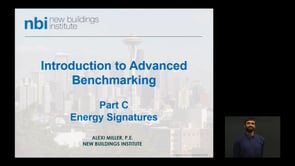Module 1 Part A – Energy Use in Buildings
Back to Main Page
Link to Module 2: Portfolio Manager and FirstView
Link to Module 3: Practicum – From Building Data to Analysis
Link to Module 4: Controls in ZNE Buildings
This section is broken up into four recorded video presentations. Please be ready to take notes and stop the videos as necessary to follow along and answer questions as they are posed by the presenters. By attempting to answer the questions, the effectiveness of this learning tool will greatly increase. Further reading and references noted in the presentations are included in this page. We encourage you to use these resources to explore your specific areas of interest in these topics.
Learning Objectives
- Understand why it is important to track building energy performance
- Define energy performance benchmarking in buildings
- Become familiar with common benchmarking methods and metrics
- Understand how to generate and apply energy signature analysis
- Define inverse energy modeling
Video Presentations

Part A – Energy Use in Buildings
Slides: Module 1 Part A – Energy Use in Buildings

Part B – Tracking Energy Data – What, Why, How
Slides: Part B – Tracking Energy Data – Why, What, How

Part C – Energy Signatures
Slides: Part C – Energy Signatures

Part D – Inverse Energy Modeling and FirstView
Slides: Part D – Inverse Energy Modeling and FirstView
Further Reading
U.S. Environmental Protection Agency
The Benefits of Benchmarking Building Performance
How the EnergyStar Score is Calculated
Key Performance Indicators (KPIs)
References
Energy Star – Portfolio Manager
CBECS (Commercial Building Energy Consumption Survey)
U.S. Energy Information Administration
Institute for Market Transformation
Smart Buildings Center: Virtual Energy Auditing Tools

These modules were developed in partnership with South Seattle College for the Sustainable Building Science Technology program.
This material is based upon work supported by the National Science Foundation under Grant No. 1406320. Any opinions, findings, and conclusions or recommendations expressed in this material are those of the author(s) and do not necessarily reflect the views of the National Science Foundation.

